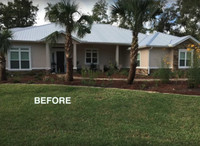



Homeowners in Florida are all too familiar with the struggle that landscaping presents for lawns exposed to unrelenting sunlight and summers either too arid or torrential to keep plants alive. The dilemma is only made worse by uncertainties where maintenance is concerned: How often should the lawn be watered? How much water should be used? Why do lawns need certain plants to thrive?
Several signs point to the root of the problem being a lack of awareness — most people just aren’t sure how to implement “waterwise” landscaping into their own home projects, or how to choose practical landscape design. To remedy the issue, First Coast native Renee Stambaugh established Native Plant Consulting, a service providing site analysis, installation, training and more for residents overwhelmed with the choices with which landscaping often presents them.
Beyond providing a service, Stambaugh’s objective is to educate the public on things such as proper plant choice, better watering habits and tending to native plants until they grow new roots and can care for themselves.
Smart landscaping decisions
“It does hurt homeowners … to not be aware,” she said. “I think they don’t know how to keep waterwise lawns because other options receive more attention. Sometimes, it’s as simple as turning off your automatic irrigation.”
To that end, Stambaugh strongly advocates for the transition from turf lawns – which require plenty of water, fertilization and chemical supplements to thrive – to that of native plant beds comprised of flora that don’t require maintenance that ultimately harms the environment.
“One of my objectives is to give people the option of reducing,” she said. “Many people are eliminating turf grass in favor of native plant beds. There are over 3,000 plants native to Florida, more than half of which are wild flowers – you could find something for your yard.”
Going local in a move Stambaugh refers to as “right plants, right place” is likely the best remedy for the landscaping dilemma. Native plants, or species that thrived even before the arrival of European settlers, don’t force the environment to compensate the way non-native plants and turf do. The latter is the root of overwatering, to which residents frequently resort when turf or non-native plants cannot survive in the environment in which they’ve been planted. The former reduces the need to frequently water or use additional supplements to thrive, as they’ve already adapted to the climate, weather patterns and exposure.
Guided learning
To help them make better decisions, Stambaugh’s Native Plant Consulting service guides bewildered clients through the process of landscape design. She begins with a survey to better understand the function of the yard in the homeowner’s lives, noting the frequency of outdoor activities, family size and special family service or utility needs. Stambaugh then asks what “feeling” the client would like their landscape to evoke – tropical, coastal or otherwise – to establish an aesthetic plan. Following the consultation, she sketches a design to scale and points clients to a list of the top 20 native plants recommended for their landscape. The list, which consists of trees, shrubs, grasses and flowers like cedar, cordgrass and beach sunflowers and their botanical names, is then used by the client to request the proper plants from a nursery.
Stambaugh’s goal with the consultative service is for clients to achieve total function of their yards, not just the desired aesthetic.
“The number one objective is to educate the customer,” she said. “But I also hope that the customers will educate others. I want people to know that there are plenty of resources out there when you research native plants, and for them to choose options that not only reduce the need for watering, fertilizing and chemicals, but to feed the wildlife so that they, too, can thrive.”
For resources on native plants, visit www.nativeplantconsulting.com.